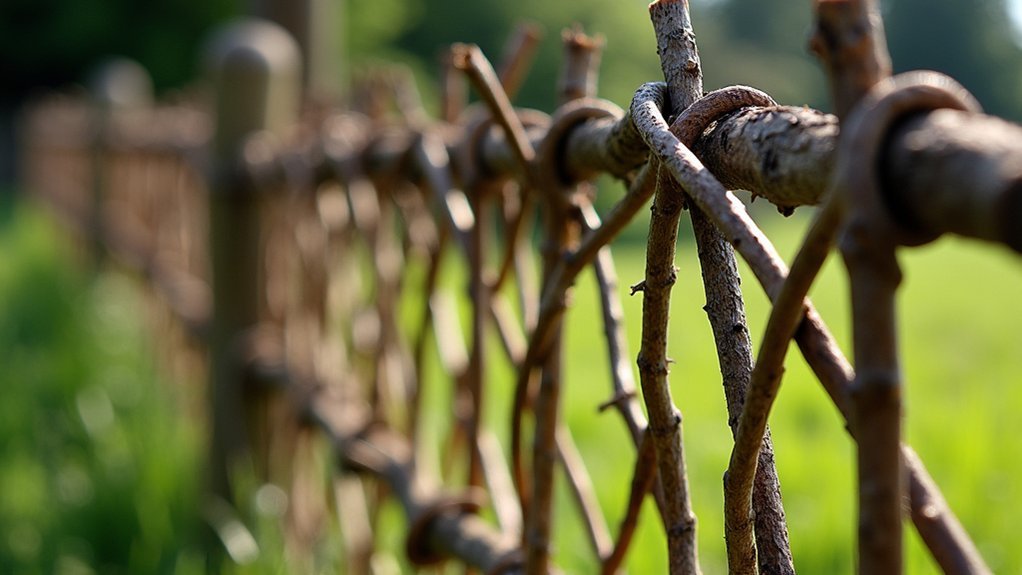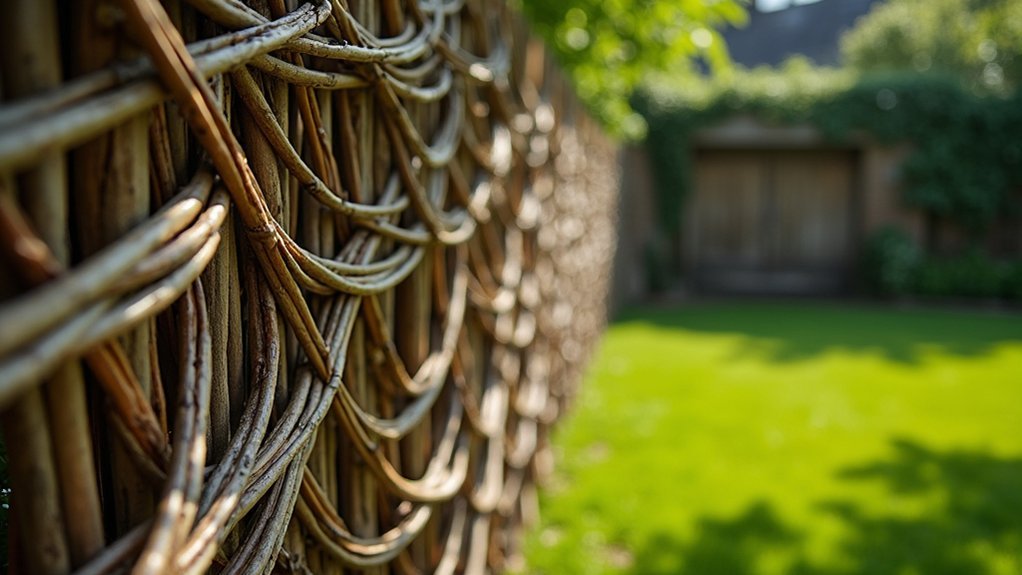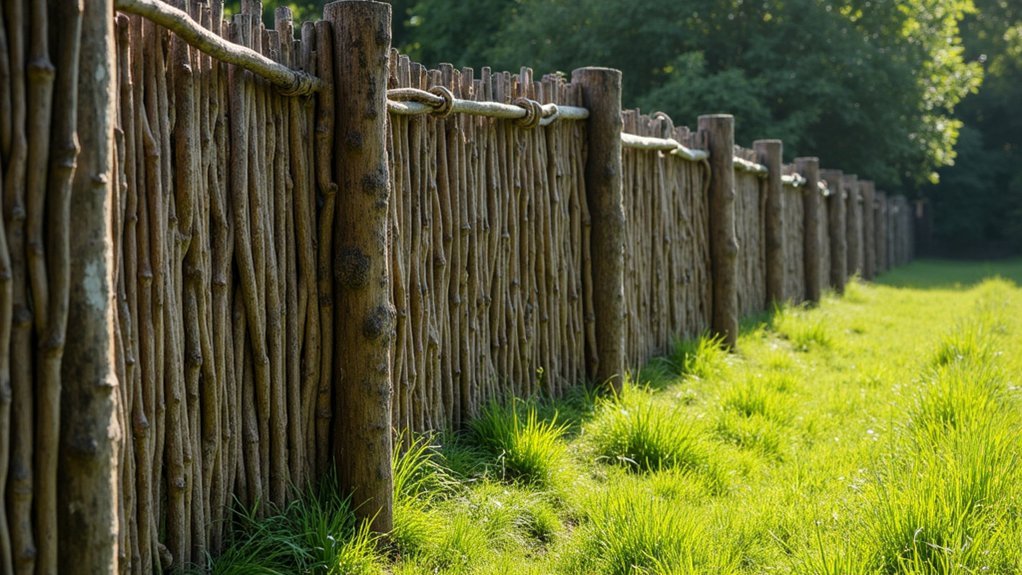Medieval wattle fences featured five distinctive patterns: the Classic Straight Lattice for field boundaries, Herringbone designs that excelled in livestock control, Curved Willow Weaving that defined garden spaces, portable Medieval Hurdle Structures for temporary enclosures, and Overlapping Branch Techniques used for village defense. You’ll find these sustainable fencing methods utilized flexible branches woven between wooden stakes, creating barriers that combined strength with repairability. Each pattern reveals centuries-old craftsmanship still admired today.
The Classic Straight Lattice Pattern: Medieval Field Divisions

While many modern fencing techniques have come and gone, the classic straight lattice pattern remains one of the most authentic medieval wattle fence designs ever created.
You’ll find this pattern primarily constructed from wooden stakes driven into the ground with flexible branches woven horizontally between them.
These fences served multiple practical purposes in medieval times – from dividing agricultural plots to controlling livestock movements and marking property boundaries. This technique dates back over 6000 years and was extensively used throughout the Middle Ages across Europe.
The beauty of this design lies in its versatility; you can adjust the weave density based on your enclosure needs.
What makes this pattern particularly effective is its combination of strength and flexibility.
When faced with harsh weather, the lattice gives slightly without breaking.
If damage occurs, you’ll appreciate how easily you can replace individual branches without rebuilding the entire structure.
Herringbone Wattle Designs for Livestock Management
Unlike its straight lattice counterpart, the herringbone wattle design represents one of medieval Europe’s most ingenious fencing innovations for livestock management. You’ll find the interlocking diagonal weave creates exceptional stability while alternating rod angles (45°-60°) distribute weight across multiple points. Continuous weave techniques with hazel infill materials create particularly durable versions of these structures, as seen in traditional European examples.
Medieval shepherds prized herringbone hurdles for their portability, enabling rotational grazing and seasonal reorganization. These structures typically used freshly harvested hazel rods (1-2cm diameter) for ideal pliability.
| Animal Type | Design Adaptation | Lifespan |
|---|---|---|
| Sheep | Standard 45° weave | 5-7 years |
| Rabbits | Buried footings, dense weave | 3-5 years |
| Livestock | Double-layered reinforcement | 10+ years |
The staked foundation system allowed relocation without permanent fixtures, while top-layer reinforcement with whole rods prevented weathering damage—extending the typical 5-7 year lifespan to a decade or more.
Curved Willow Weaving in Manor Garden Enclosures

In medieval manor gardens, curved willow weaving represented both artistic expression and practical enclosure innovation. You’d find these elegant boundaries created from flexible “withies” – young willow saplings managed through pollarding and coppicing techniques that guaranteed sustainable material supplies.
Unlike the utilitarian herringbone patterns used for livestock, these curved designs served multiple functions in garden settings. They defined spaces while providing windbreaks for delicate plants and supporting climbing vegetation. These structures were particularly effective for supporting climbing plants like beans and peas that were commonly grown in kitchen gardens.
Their organic, flowing forms harmonized naturally with garden pathways and water features. You could maintain these fences relatively easily, with regular pruning and occasional replacement of weathered sections.
The living posts often took root, creating semi-permanent structures that blended seamlessly with the landscape – a reflection of medieval gardeners’ understanding of both aesthetics and environmental adaptation.
Medieval Hurdle Structures for Portable Boundaries
Medieval hurdle structures emerged as remarkably practical portable boundaries throughout the agricultural landscape of early medieval England. Typically measuring 1.80 meters long and 1.00-1.50 meters high, these wooden panels featured wattle construction—a weaving technique requiring carefully selected sticks to guarantee durability without breakage.
You’ll find these structures were essential for managing sheep during grazing, shearing, and dipping operations. Their design prioritized utility over decoration, with multiple upright supports and horizontal weaving that could be adjusted based on needed security. Craftsmen traditionally used sweet chestnut wood because of its excellent splitting properties and natural durability without treatment.
| Function | Construction | Historical Significance |
|---|---|---|
| Livestock Control | Woven Sticks | Rural Land Management |
| Temporary Pens | Variable Weave Density | Medieval Enclosure Practices |
| Shearing Enclosures | Upright Supports | Agricultural Innovation |
| Portable Fencing | Southern England Origin | Preserved Craftsmanship |
Overlapping Branch Techniques in Village Defensive Fencing

Traditional village defense relied heavily on the overlapping branch technique, a method that transformed simple woodland materials into formidable protective barriers. You’d find willow, ash, and hazel branches carefully selected for this purpose—thicker ones serving as stakes, thinner ones for weaving.
When constructing these defensive structures, you’d weave smaller branches in and out of vertical stakes, creating tension that strengthened the entire fence. This technique originated in the Middle Ages as an effective method for both defense and animal management. This overlapping technique provided remarkable resilience against both wildlife threats and potential raiders.
Medieval villagers developed various patterns—simple horizontal weaves were most common, while diagonal weaves offered enhanced strength.
These protective boundaries weren’t just functional; they represented medieval ingenuity at its finest. Local variations emerged across regions, with craftsmen adapting designs based on available materials and specific defensive needs.
Frequently Asked Questions
How Long Did Medieval Wattle Fences Typically Last Before Requiring Replacement?
Your medieval wattle fence would typically last six or more years before needing significant repairs, though well-maintained ones could endure for decades with only minor fixes as specific sections degraded over time.
Were Different Woods Used for Wattle Fencing Based on Regional Availability?
Yes, you’d find regional variations in wattle wood choices. You’d use willow in England, while in other European areas you’d work with locally available species like alder or beech based on what’s accessible nearby.
Did Fence Patterns Vary by Social Class or Economic Status?
Yes, you’d notice fence patterns varied by wealth. While rich landowners used higher quality materials and larger posts, poor farmers relied on simpler wattle designs with whatever wood they could afford or gather.
How Were Wattle Fences Maintained During Harsh Winter Conditions?
You’d clear snow regularly, apply daub to seal gaps, pollard willows in fall for spring repairs, and check for frost-heaved posts. Living fences required less maintenance as they’d naturally regrow after winter damage.
What Tools Were Essential for Authentic Medieval Wattle Fence Construction?
You’d need essential hand tools like axes, mallets, and chisels for shaping wood. Don’t forget shovels for digging post holes, saws for cutting branches, and plant fibers for binding wattle sections together.
In Summary
You’ve now explored five authentic medieval wattle fence patterns that showcase our ancestors’ remarkable craftsmanship. Whether you’re recreating a period garden, building practical livestock enclosures, or simply appreciating traditional techniques, these designs offer historically accurate inspiration. Try your hand at weaving these patterns with local materials, and you’ll connect with centuries-old traditions while creating beautiful, functional boundaries that stand the test of time—just as they did in medieval villages.





Leave a Reply